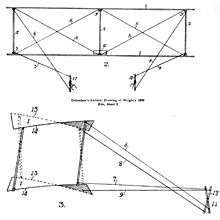Wing warping

Wing warping was an early system for lateral (roll) control of a fixed-wing aircraft. The technique, used and patented by the Wright brothers, consisted of a system of pulleys and cables to twist the trailing edges of the wings in opposite directions. In many respects, this approach is similar to that used to trim the performance of a paper airplane by curling the paper at the back of its wings.
Many birds use wing warping to achieve control. This was a significant influence on early aircraft designers.
Description
In practice, since most wing warping designs involved flexing of structural members, they were difficult to control and liable to cause structural failure. Ailerons had begun to replace wing warping as the most common means of achieving lateral control as early as 1911, especially in biplane designs. Monoplane wings of the period were much more flexible, and proved more amenable to wing warping – but even for monoplane designs, ailerons became the norm after 1915.
Lateral (roll) control in early aircraft was problematic at best. An overly flexible, involuntarily twisting wing can cause involuntary rolling, but even worse, it can convert attempts at correction, either from wing warping or ailerons, into a counteracting "servo tab" effect. Once this was fully understood, wing structures were made progressively more rigid, precluding wing warping altogether – and aircraft became far more controllable in the lateral plane.
Applications
Wing warping was a common feature of early aircraft, including:
- The Wright Flyer (1903)
- The Antoinette V (1908), a wing-warping variant of the Antoinette IV
- The Blériot XI (1909) following modifications introduced by Raymond Saulnier
- The Etrich Taube (1909) originally used a cable-warped horizontal stabilizer trailing edge to give elevator functionality as well
- The Morane-Saulnier N (1914), a World War I French scout
- The Caudron G.4 (1915), a French biplane with twin engines.
- The Fokker Eindecker (1915), the very first German fighter plane
Modern re-assessment
Several of the reproduction planes built for the film Those Magnificent Men in Their Flying Machines used the wing warping control systems of the original aircraft – with mixed results. The wing warping of the Avro Triplane proved surprisingly successful, whereas on the reproduction Antoinette, with its very flexible wing, wing warping offered little effective lateral control. Since the original Antoinette-style ailerons would have probably been even less effective, unobtrusive "modern" ailerons were inserted – even with these, lateral control remained very poor.[1]
Wing morphing is a modern-day extension of wing warping in which the aerodynamic shape of the wing is modified under computer control. The technique, it is hoped, will give improved control at flying speeds near the speed of sound, where traditional control surfaces are less effective. Wing warping and wing morphing are also currently used to get extra control over an aircraft during difficult times such as in a storm. Research into this field is mainly conducted by NASA.
See also
- Aileron
- M. P. W. Boulton, the British inventor (1868) of the aileron
- Elevon – a combination elevator/aileron used on Bleriot's earliest designs and more recently on flying wing and delta wing aircraft.
References
- ↑ Wheeler, Allen H. Building Aeroplanes for "Those Magnificent Men.". London: G.T. Foulis, 1965.
External links
- NASA – interactive diagram of wing warping used on the Wright Flyer
- Centennial of flight – illustration of Wilbur Wright invention of wing warping using a cardboard box
- Aerospaceweb – Origins of Control Surfaces
- PBS – What's Wing Warping?
- Flight demo of Owl's Head Transportation Museum's Etrich Taube reproduction, demonstrating warping wingtips and stabilizer